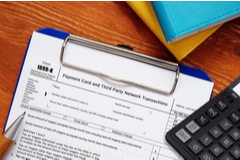CLARION, Pa. (EYT) – Clarion H&R Block submitted the following article: 1099-K Form – Everything You Need to Know.
(Photo above by Dave Cyphert of ProPoint Media Photography.)
Form 1099-K has been around for a while, but it’s received more attention recently because of a recent rule change. With the change, it was expected that many more people would get this form in 2023.
However, the IRS announced on Dec. 23, 2022, the new rule will be delayed. So, what does this twist mean, and what applies to your 2022 taxes (filed in 2023)?

Here’s what we know:
- In general, the rules for sending Form 1099-K for tax year 2022 will apply as they did for tax year 2021 according to the IRS announcement.
- Some people will still receive Form 1099-K for tax year 2022 early in 2023 based on the previous rules. With the delay of the rule, not as many people will be affected as expected this year.
Read on to dig into the details, starting with what this form is all about. And, if you do receive Form 1099-K, you can count on H&R Block to help you navigate your taxes.
Explore the ways you can file taxes with H&R Block.
What is a 1099-K?
The 1099-K form reports payments and transactions from online platforms, apps or payment card processors. Officially, this document is called “Form 1099-K: Payment Card and Third Party Network Transactions,” which may shed some light on who sends these forms and why.
What changed with 1099-K rules? And what’s been delayed?
A new tax law, and then a delay of that law? Yeah, it’s a lot to digest. With all the changes, you may be wondering if you’re totally caught-up on what’s new.
To keep it simple, we’ve noted the big changes.
- $600 rule passed in 2021 – In early 2021, a law was passed dropping the 1099-K requirements for 2022 from $20,000 (and 200 transactions) to $600 from any one platform. This law is meant to apply to payments for goods and services but could have included personal payments from apps such as Venmo, Paypal, Etsy, and Ticketmaster, to name a few.
- $600 rule delayed on Dec. 2022 – On Dec. 23, the IRS announced that the new $600 rule would be delayed and that the previous rules will apply for 2022 returns. You should expect a 1099-K form if you had $20,000 or more in payments or 200 or more transactions from any one platform related to goods or services.
We should note that some businesses may still send a 1099-K. They may have either prepared them before the rule was delayed, or they may send forms regardless of the amount you received. In either case, we can help you determine how to handle your 1099-K.
Looking ahead to 2023 returns (filed in 2024): Removing personal transactions
The delay is only for one year, so the $600 rule is expected to apply again for tax year 2023. But the delay also allows the IRS time to provide additional instructions, so people are less likely to receive a form for personal transactions (ex. money from friends for rent or a rideshare).
The bottom line: If you receive payments for goods and services in 2023 from an app or online platform, it’s a good idea to keep your receipts.
What is a 1099-K used for? What do I do with it?
The platform or app you used will send two copies of your 1099-K information. One is for you, so you can prepare your taxes. The other will go to the IRS as a record of your transactions.
Additionally, it’s good to keep in mind not all 1099-K transactions are alike, and the tax treatment can vary. No matter what triggers your form, H&R Block can help you report income from your 1099-K.
Do I have to pay taxes on 1099-K?
This will largely depend on your situation. If you received Form 1099-K for items you’ve sold (like a vintage record or grandpa’s antique watch), goods related to your hobby, or goods or services related to your business, there’s a bit more math and review involved. Generally, if you’ve made a profit, it’s possible you’ll owe taxes.
How do I report 1099-K income on my tax return?
How you report the income will depend on why you received it. Here are the 1099-K instructions for a couple of common scenarios.
- Hobby income – You’ll report your gross hobby income on Schedule 1 (Form 1040), and include the Form 1099-K’s issuer’s name and EIN. Learn more about Hobby income.
- Business income – If you’re a sole proprietor, like an independent contractor, you’ll report the income on Schedule C (Form 1040), line 1 and any returns or allowances on Schedule C, line 2. Additionally, you must calculate the cost of goods sold and report that on Schedule C, line 4. Then deduct associated business expenses in Part II of Schedule C.
Get help with Form 1099-K
When it’s time to report the information on your Form 1099-K, you won’t have to do it alone. No matter what triggered your Form 1099-K, you can count on H&R Block to help you navigate any income you received from an online platform.
For more information on all of the ways to receive help from H&R Block when filing taxes this season, visit Clarion H&R Block.
Copyright © 2023 EYT Media Group, Inc. All rights reserved. Any copying, redistribution or retransmission of the contents of this service without the express written consent of EYT Media Group, Inc. is expressly prohibited.

